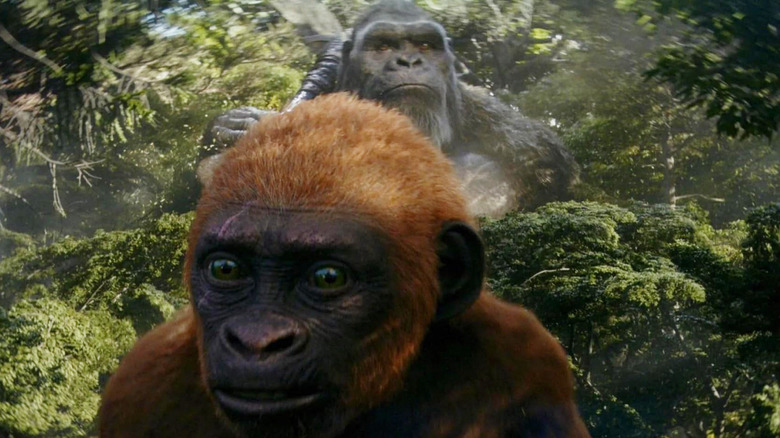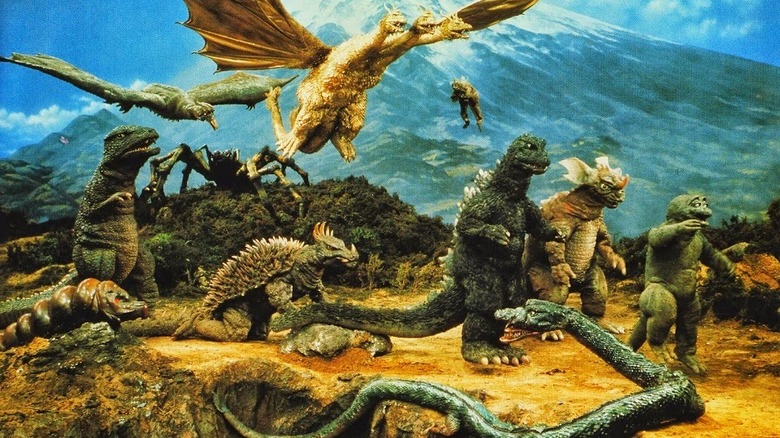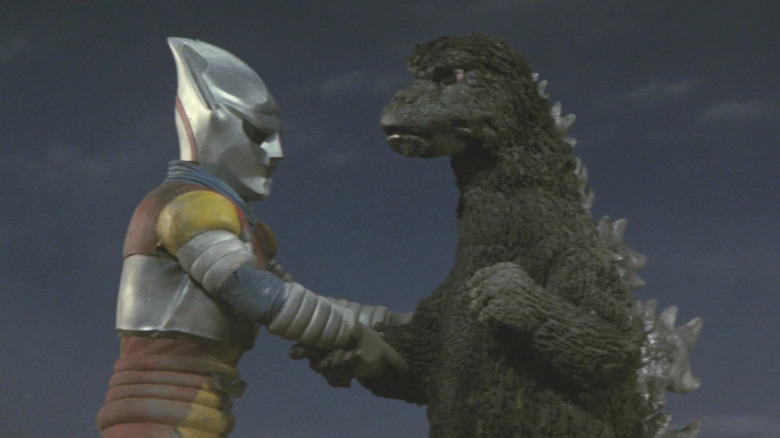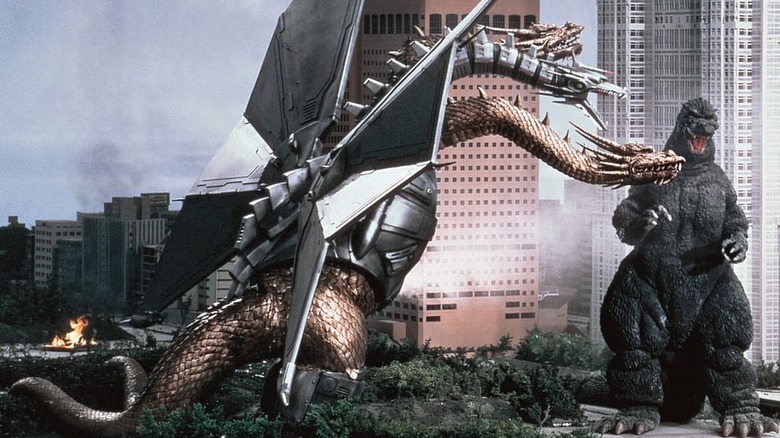Godzilla X Kong: The New Empire Fits Right In With The Showa Era Of Monster Movies
Adam Wingard's new film "Godzilla x Kong: The New Empire" has, tonally speaking, strayed far from Gareth Edwards' 2014 MonsterVerse kickoff film "Godzilla." Edwards' film was somber and sad, featuring very little "fun" monster destruction. As the MonserVerse series has progressed, however, it has crept inexorably toward a sillier tone before striking it rich with Wingard's 2021 entry "Godzilla vs. Kong." That film featured a battle between the titular titans, but also a cameo from Mechagodzilla, a monstrous robot extrapolated from the skull of the dead King Ghidorah. "GvK" also featured a fleet of human-built UFOs and a magical portal that led into the Hollow Earth, an unusual underground realm ruled by monsters.
The Hollow Earth idea is straight out of Jules Verne, but the mayhem-forward approach to a Godzilla movie comes from several of Toho's films released in the 1970s. Indeed, many critics and pundits have been comparing "GxK" to the series' Shōwa era, the "Godzilla" films made between 1954 and 1975.
It should be stated right away that the Shōwa era also began on a very somber note. Ishiro Honda's 1954 "Gojira" was an overwhelmingly sad and downbeat movie. Godzilla was not yet fighting other monsters, serving as Japan's bouncer. In the beginning, the monster was a force of destruction, an echo of the nuclear devastation wrought on Japan by the United States only a few years earlier. Japan was able to defeat Godzilla, but only after inventing a weapon of mass destruction even more devastating than a nuclear bomb. Humans won, but at what cost?
Fast-forward to 1972's "Godzilla vs. Megalon," and Godzilla is beating up a drill-handed beetle with the help of a shape-shifting robot named Jet Jaguar. It's latter-day Shōwa-era films specifically that "GxK" can be compared to.
The evolution of Godzilla
The shift from 1954's "Gojira" to the campiness the series became known for was very gradual and even involved some misinterpretation. "Gojira" was a success, and Toho rushed a sequel, "Godzilla Raids Again" into production. Honda didn't return for "Raids Again," with Motoyoshi Oda taking the reins, getting the film made and released only five months after the original. The next Godzilla movie, Honda's "King Kong vs. Godzilla," wouldn't be released until 1962, and by then, Toho's monster movies had changed greatly. In the intervening years, audiences were treated to "Rodan," "the Mysterians," "Varan, the Unbelievable," and the first "Mothra" movie. The effects on the films became slicker with each passing entry, and Toho's output tilted toward a more populist tone.
The Shōwa era began to peak in the mid-1960s with the release of Honda's films "Ghidorah, the Three-Headed Monster" (1964) and "Invasion of Astro-Monster" (1965). Peppered around those films were Godzilla-adjacent showcases like "Frankenstein Conquers the World" (also '65), "War of the Gargantuas" (also '65), and "King Kong Escapes" (1967). The pinnacle of the Shōwa era came with the 1968 release of "Destroy All Monsters," a mash-up of epic proportions wherein Godzilla fought King Ghodirah alongside a dozen other established Toho monsters.
Walter Chaw, in a brilliant 2023 essay written for RogerEbert.com, pointed out that "Destroy All Monsters" was not presented as something campy and weird, but an earnest expression of Japanese national character. Godzilla, a scar left over from the war, became a symbol for the country's barely-contained fury, a representation of Japanese power wrought from repressed revenge. It's only the bad re-edits and clumsy English-language dubbing that had Americans assuming all Godzilla films were camp.
Actual silliness wouldn't come until later.
Godzilla in the '70s
Ishiro Honda would only make two more movies in the Godzilla series after "Destroy All Monsters," with one of them being "Terror of Mechagodzilla" in 1975, which was kind of a "last hurrah" for the series and one of its founding directors. In 1972, director Jun Fukuda took over, directing "Godzilla vs. Gigan," "Godzilla vs. Megalon," and "Godzilla vs. Mechagodzilla." These three films took on a much more salacious, toyetic approach to Godzilla, highlighting bigger, sillier stories, weirder monsters, and a Godzilla who had fully shed any connection he once had to nuclear devastation. The series was now kid-friendly, goofy, and more effects-heavy.
Gigan might serve as the central symbol for this unofficial trilogy of films, as the monster is weird in that "a little kid invented it" sort of way. Gigan was a bird/reptile that had been transformed into a semi-mechanical cyborg by a species of insectoid aliens called the Nebulans. Gigan had metal hooks for hands, a glass panel for eyes, and a buzzsaw in its stomach. It still, however, sported feathers and scaly feet. Gigan is a weird, weird monster. The plot of "Godzilla vs. Gigan" surrounds an amusement park with a life-size Godzilla statue.
Adam Wingard seems to have taken most of his creative cues, however, from "Godzilla vs. Megalon." Both films feature underground civilizations with control over a monster tasked with defending them. In the 1973 film, the monster is the titular Megalon, summoned by the people of Seatopia. In the 2024 film, the monster is Godzilla, although his "owners" shall remain unrevealed for the time being.
Both films also feature Godzilla and/or Kong receiving mechanical aid from human technology. In Wingard's film, Kong is outfitted with a massive mechanical arm. In "Megalon," it's Jet Jaguar.
Things still got silly
Jet Jaguar, as Godzilla fans may know, was conceived of by a young Godzilla fan who offered robot designs to Toho as part of a sweepstakes. Jet Jaguar was altered greatly from its original designs, but it remains an artifact of fanfic-like contributions. By the time Jet Jaguar has Megalon in a headlock and Godzilla gives a flying kick to his abdomen, any thematic notions of nuclear annihilation or the Japanese national character have fallen away. As of now, we're just here for the monster mayhem.
"Godzilla x Kong: The New Empire" is also here just for monster mayhem. Wingard is not making a comment on America's politics, the nuclear bomb, or the overwhelming awesomeness of natural disasters. It's all about the status quo, baby. Wingard just wants King Kong to pick up a smaller ape and use him as a club to beat another ape in the head. "GxK" isn't so much a reflection of the whole Showa era, but the Jun Fukuda films in particular. His use of Mechagodzilla in "Godzilla vs. Kong" bears this out.
Of course, Toho returned to silliness frequently for years thereafter. The series rebooted in 1984, the beginning of the Heisei era. By 1991, Kazui Omori's "Godzilla vs. King Ghidorah" was released, and that film features time travel, a mechanical Ghidorah, and the deliberate creation of Godzilla by human hands. The G-man was literally free of his wartime origins, now serving as an instrument of justice. The Heisei era was rarely somber, even when Godzilla died in "Godzilla vs. Destoroyah" in 1995. Even several of the films in the Millennium era — "Godzilla vs. Megaguirus" and "Godzilla Against Mechagodzilla" in particular — were more about amazing monster fight choreography than plot or theme.
"Godzilla x Kong" is just following that tradition.
A couple of /Film's editors had a spoiler-filled discussion about the movie on today's episode of the /Film Daily podcast, which you can listen to below:
You can subscribe to /Film Daily on Apple Podcasts, Overcast, Spotify, or wherever you get your podcasts, and send your feedback, questions, comments, concerns, and mailbag topics to us at bpearson@slashfilm.com. Please leave your name and general geographic location in case we mention your e-mail on the air.



